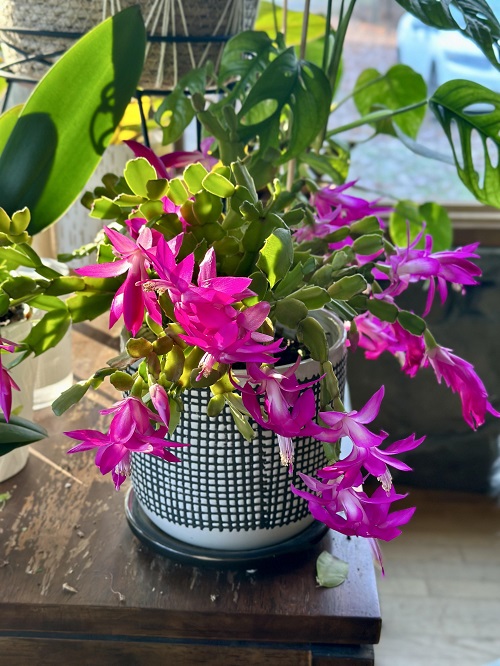Are you having a hard time getting your Christmas cactus to bloom? If yes, then with this secret tip, you can get tons of Christmas cactus flowers every year!

What’s a Christmas cactus without its iconic blooms? But getting them to flower can be tricky if you don’t have the right know-how. This article is here to solve the problem of every gardener dealing with a barren Christmas cactus. So read on, and don’t forget to share this post if you like it!
Ideal Conditions to Get Your Christmas Cactus to Bloom
Christmas cacti, scientifically known as Schlumbergera, are epiphytes native to the rainforests of southeast Brazil. They are late bloomers, producing flowers in winter around the holiday season. To encourage this floral bloom, you need to mimic the conditions of its natural habitat.
Sunlight

Since it grows in crowded rainforests, it needs bright yet indirect light. As a matter of fact, direct sunlight is harmful to the plant. Place your Christmas cactus in a location with 4–6 hours of bright, indirect light daily.
An east-facing window is ideal for growing it indoors, if you have got a south-facing window, provide a sheer curtain for dappled sunshine.
Ensure it is protected from the afternoon sun and exposed to only filtered light. As these cacti are short-day plants, you should give your cactus 8–10 hours of darkness each night in the fall and winter; we’ve shared how to do it below.
Soil Type

This tropical succulent requires a mildly moist growing medium. However, the soil should also be well-draining due to its high water retention. A mixture of coarse sand or perlite can achieve this.
You can also add a bit of pine bark for extra drainage. Just avoid any heavy, clay-based soil, as it can retain too much water and lead to root rot.
Watering Frequency
This varies from season to season and also depends on pot size and growing location. The Christmas cactus needs more moisture during its active growing season than most succulents. Try watering it once you see the soil is dry.
However, during its dormant period, the watering must be significantly reduced. As a rule of thumb, when it’s blooming, water it when the top inch of soil is dry so the soil stays consistently moist but not wet. You can check the soil moisture every three to four days.
After blooming, reduce watering as the plant rests. You can even propagate one of these in water.
Humidity Levels and Temperature

Christmas cacti thrive in high-air moisture environments (making them perfect for bathrooms). Make sure the humidity remains over 50% for a healthy plant. You can use humidifiers or pebble trays to increase the air moisture levels.
This plant is also temperature-sensitive. It does best when the day temperature is between 70 and 80 F (21-26 C). While it can dip to 55 and 65 F (12-18 C) at night, anything higher or lower than these extremes can harm the plant’s health.
The Trick for Getting Tons of Blooms Every Year
The secret to the Christmas cactus’s abundant flowers lies in its anatomy. The plant is day-length sensitive, and seasons and the amount of sunlight can greatly affect the number of flowers you’ll get.
You need to keep the plant away from light for an uninterrupted 14 hours daily from September or early October for 6-8 weeks.
Any artificial light source should also be removed from the plant’s immediate surroundings. Being short-day plants, Christmas cacti respond well to dark autumn nights and start to flower.
This doesn’t mean that the plant can survive without any sunlight! Expose it to bright indirect sunlight for about 4-6 hours, but put it someplace dark afterward. If your plant is big, get a mobile plant stand so you can move the pot easily.
Pro Tip: You can use a cardboard box, relocate the pot, or use a dark sheet of paper to mimic nighttime conditions.
Why Does the Trick Work?

Christmas cacti need a dormant period to glower. If they are kept in bright light for long hours, the plant is tricked into continuously growing, subsequently tiring itself out. It does not dedicate any energy or resources to flowers later on.
Cooler temperatures and darkness are vital for promoting the budding process and eventual flowering. Hence, the bright day and dark night trick. Try it for yourself and get tons of Christmas cactus flowers every year without a miss!


